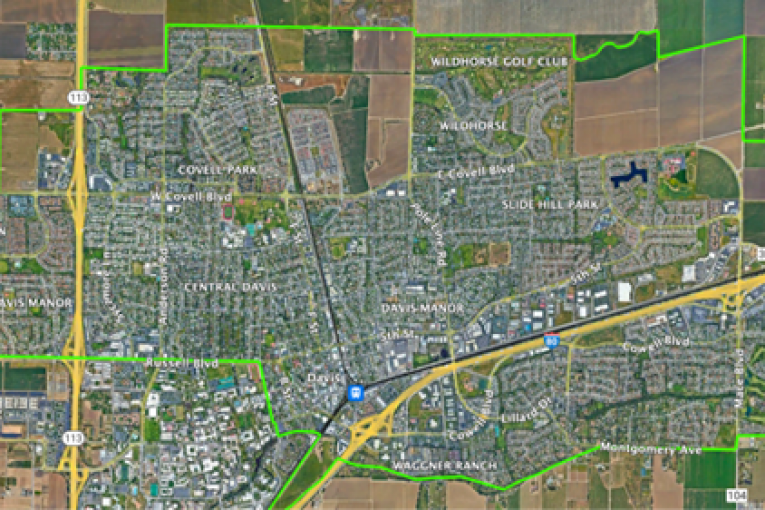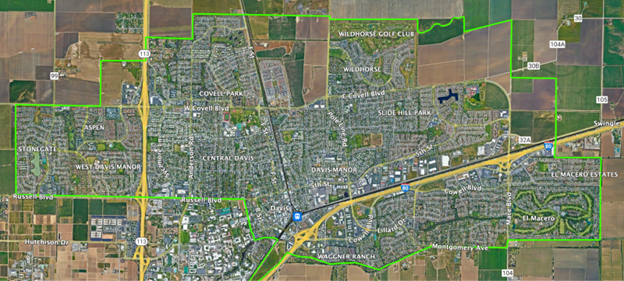

by Tim Keller
In Monday’s column, David Greenwald made an observation that, while there HAS been discussion in City Hall around pursuing a Measure J/R/D amendment in City Hall, they might wait until 2026 to put it on the ballot.
His sentiment was that this might “make sense” because there are likely to be “at least one if not two additional Measure J votes by then.”
I think very differently.
In my view, the Measure J amendment needs to be on the 2024 ballot, or we shouldn’t bother, and there are multiple reasons why it should come BEFORE the impending Measure J votes.
First: The entire point of the current exemption strategy is to allow growth IF (and only if) it conforms to a much more modern and sustainable concept of integrated city design. This design concept is called “a 15 minute city” or “transit oriented development” and requires a top-down master-plan of medium density housing, planned  along a transit corridor that connects all of that density to places of employment and shopping. It is an integrated planning approach that requires both density AND transit, planned together, or it doesn’t work.
along a transit corridor that connects all of that density to places of employment and shopping. It is an integrated planning approach that requires both density AND transit, planned together, or it doesn’t work.
If we pass Village Farms or the Shriners development FIRST, then we have effectively blocked a large percentage of the proposed transit line with low density neighborhoods AND spaced out the areas where we CAN put some denser housing in… which will reduce the potential effectiveness of that entire line.
If we pass Village Farms and Shriners, the proposed transit corridor probably no longer makes sense unless there are substantial revisions in the current plans.
Second: Building anything at low density within the proposed urban limit line compromises the very concept of establishing a “real” limit line.
I showed in my articles last year that there IS ample room within the proposed limit line to provide a buffer for 30 to 50 years of growth – more than enough time for the city to then figure out how to effectively densify its core.
THAT is the balancing act that the Measure J/R/D amendment gets us: it buys us TIME for figuring out how to densify, and THAT is how we make an urban limit line that is indeed “real” – not a temporary demarcation to be moved later.
If we consume half of the land within the proposed limit line with low-density housing, the urban limit line concept falls apart, and we will regret it.
Third: We run the risk of letting the perfect be the enemy of the good.
Let’s think about how voters make land use decisions in this city:
- There is a fraction of the town that will vote against everything,
- A fraction that will vote for everything,
- And a middle contingent that trends towards “no” and will vote no if given a reason to, but is capable of voting yes if the concept passes muster.
That is a somewhat simplistic, but generally accurate assessment in my opinion.
The two Measure J/R/D projects already have a lot for this middle contingency to dislike:
- They are low density “sprawl.”
- They ignore modern city design principles.
- They are car-centric and will have the worst kind of traffic impact of any way we could possibly build.
- They are going to have twice the climate impact of more sustainably conceived housing.
- They are going to require subsidies from the city to maintain in the long term.
- The Village Farms proposal might be building on a potential vernal pool.
Are all of these arguments sounding familiar?
These are the reasons why these developments are already going to be a hard sell at the ballot box, especially in special elections. But now let’s add in the variable of a potential vote to modify Measure J/R/D:
If the Measure J/R/D Amendment vote is pushed back to 2026:
As discussed above, the passage of either Village Farms or Shriners is something that fundamentally compromises the concept of the Measure J/R/D amendment, makes the urban limit line it enshrines almost pointless, and negates our ability to implement transit-oriented development in Davis.
This provides incentive for middle-ground voters, like me, to vote against the two peripheral proposals because we would rather have something better and more sustainable. We would be rejecting something “good” for the hopes of holding out for something “much better.” (A reasonable position, given how permanent these decisions are going to be, and a kind of voter logic that we have seen expressed many times before. )
And of course, if the projects fail AND then Measure J/R/D fails in 2026, we would really have made the perfect the enemy of the good, and we are back at square one.
If Measure J Amendment vote is in 2024:
If the Measure J/R/D amendment is on the ballot THIS YEAR however, this decision matrix is quite different:
If the Measure J/R/D Amendment comes BEFORE the current peripheral proposals and FAILS at the ballot box, then the “better option” that we had hoped for will be off the table. This means the above-mentioned swing voters will be more likely to vote FOR Shriners and Village Farms, because we will have already tried for “perfect” and will be more willing to accept “the good.” There will no longer be any hope for a better option.
I further think that the peripheral proposals stand a better chance in this scenario just because of the issue attention cycle: The Measure J/R/D amendment, and the state-mandated imperatives for growth that are behind it will be SO well discussed in the previous campaign, that voters will understand fully that we need to do SOMETHING.
If the Measure J/R/D exemption succeeds, however, then we have all the choices in the world:
Developers will be able to decide if they want to continue their campaigns to do it “their way” and voters will have the opportunity to decide between two forms of growth: Transit-oriented medium density, or more conventional low-density.
This is the best possible scenario that gives us the best shot at the best slate of potential outcomes in this situation.
So for anyone in our city who thinks that we might be able to delay the discussion of modifying Measure J/R/D until 2026… I’m sorry. We are in this situation PRECISELY because we have been kicking the can down the road on the issue of growth for a generation. That needs to stop NOW.
The Measure J/R/D amendment needs to be on the 2024 ballot, or not at all.






Agreed. Your logic in your conclusion makes sense. Rushing off the wrong solution, especially one that may be rejected, is worse than deferring the solution. Why not make success more probable?
To clarify, I was not advocating waiting until 2026, I was predicting that’s what the council would decide to do.
I didnt see your statement as a position or advocacy, but certainly I wanted to point out that:
1) These options before us, are not equal, and interchangable.
2) The reflex that city hall might have to try to delay taking on something controvercial, has not served us well in the past, and really cant continue.
We know measure J is the root cause of our dysfunction. If we know that, why do anything else but try to solve if directly?
I suspect that gets complicated because I think a substantial portion of the population of Davis, perhaps even a sizable majority disagrees with that and the elected officials are risk averse and risk avoidant.
I’m thinking this might be a factor:
Don, I would agree the data you are presenting is a big factor, but I think in a different way you are suggesting.
That passage rates for measure J/R/D is indeed proof that citizens do NOT want runaway growth, and thats it. From how people talk about these sentiments, what they want to avoid with measure J/R/D is “sprawl”.. AKA… large tracts of single family homes on the edge of town.
In my analysis, that puts this population on the side of preserving measure J by modifying it, and adopting an urban limit line.
When the choice is between modifying measure J to KEEP that anti-sprawl policy versus having J overturned by the courts or the state and opening up the floodgates to the kind of development none of us want, I think this same population that voted to uphold measure D will vote to modify it.
I’m one who disagrees with that. Measure J was a response to egregiously bad planning. Yes, it’s a meat ax rather than a scalpel, but it has prevented a lot of undesirable urban growth.
That said, I’m amenable to a modification of Measure J if it rigorously adheres to the goals that Tim has described previously. I’m very skeptical that the CC can resist the pressure to insert back-door exceptions that would allow business-as-usual, but I’m open to seeing the process move forward.
.
I am another person who disagrees with that. However, I differ slightly with Jim that it wasn’t just egregiously bad planning that was the reason Measure J was drawn up and passed. The events leading up to Measure J were very much like the Mace Mess, which is reported to have cost the City over $10 million on a project that was planned to be $3 million. Beyond the planning failures, the City failed (A) in enforcing and complying with the legal terms of the development agreement / development plan and (B) in its commitment to keeping its constituents informed. In both cases changes were made in backroom negotiations outside of the “light of day.”
This is the same pattern of behavior that was at the heart of the Brightnight debacle … the three amendments to the Cannery development agreement … and imposition of a tens of millions of dollars tax burden on taxpayers in both the Mace Ranch CFD and the Cannery CFD situations.
Measure J is at its heart an outward and visible sign of the inward and spiritual distrust Davis constituents have for local government.
And Davisites did not use to mistrust their government. This is something that has arisen over the last quarter century. It would be interesting to try to trace back to what changed.
Richard, I’m not sure we could effectively or accurately trace that back, but I do have my own personal speculations, which I will share here.
Michelle Weiss, back when she was on the FBC made the following observation during one of our FBC meetings. She said, “Davis has promised itself a very “rich” and broad suite of services, but has also not promised to provide enough tax revenues to pay for those services.”
I believe she was 100% correct in that.
As long as housing growth provided City Council with enough Ponzi Scheme revenues to pay for the services the citizens couldn’t see the impending fiscal cliff. Once those Ponzi Scheme revenues started to dry up the Davis government began hiding the ball.
Matt:
Jim:
Question for both of you: Would you prefer that we make the attempt to fully draft the ammendment ourselves outside of city hall and collect signatures to get it on the ballot ourselves?
Tim, the challenge is the same for getting Council to act as it is for signature gathering as you propose. That challenge is clearly illuminated in Don’s graphic
https://www.davisvanguard.org/wp-content/uploads/2024/02/Screen-Shot-2024-02-15-at-3.33.02-PM-500×144.png